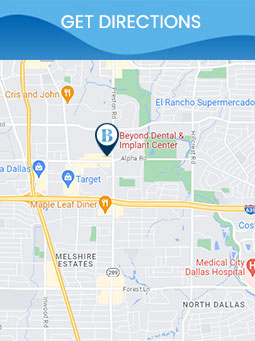Sinus Lift Procedure Specialist in Dallas, TX
A sinus lift is a surgical procedure that is performed to restore strength and mass to your jawbone while simultaneously protecting your maxillary sinus cavities. This allows implants to be successfully placed. At Beyond Dental & Implant Center we provide sinus lift treatment to improve the success of implants in your upper jaw. Contact us for more information or request an appointment online.
Table of Contents:
How does bone loss affect implant stability?
Sinus lift
Bone grafting for a sinus lift
Your sinus lift procedure
When you lose teeth, your entire life is affected. Dental implants are a modern treatment for tooth replacement that has quickly become the most popular treatment available. This treatment uses small titanium posts that are surgically placed into your jawbone. These posts are then used to provide support for your dental restorations, or ceramic crowns. Dental implants can be used in several situations and have a 98% success rate. To be successful, however, you need to have sufficient bone mass remaining in your jaw. Too little bone mass can result in loose implants or implant failure. In your upper jaw, implants can also compromise your maxillary sinus cavities. At Beyond Dental and Implant Center, we can help to improve the success of implants in your upper jaw with a sinus lift.
Your teeth provide a very important function for the health of your jawbone. Every time that you chew, the roots of your teeth stimulate your jaw. This triggers your body to send the nutrients needed for the strength of the bone. When you lose teeth, stimulation is lost. As a result, fewer nutrients are sent. This causes the bone to gradually lose mass, which causes the bone to weaken. Placing implants in weak bone results in loose implants that may not properly integrate. They may not even integrate at all. These issues compromise the stability of your dental restorations.
In your upper jaw, the roots of some of your teeth reach near the maxillary sinus cavities, which are located just behind your cheeks. Losing these teeth means that not only does the bone lose mass, but the distance between the jaw and the sinus cavities thins. Not only can this affect the stability of your implants, but it can also compromise your sinus cavities. Implant posts may piece the cavities, which can cause problems such as chronic sinus infections.
A sinus lift is a surgical procedure that is performed to restore strength and mass to your jawbone while simultaneously protecting your maxillary sinus cavities. This allows implants to be successfully placed. The procedure involves a bone graft, which not only restores strength to your jaw but also creates enough space between the jaw and your sinus cavities.
There are a few different types of bone grafts that may be used for your sinus lift. We will determine the best type of graft during your initial consultation that will provide you with the best results.
• Autograft. An autograft is a procedure that uses bone mass from your own body. While this requires two surgical sites, there is no risk of disease transmission.
• Allograft. An allograft uses bone mass from a compatible donor. The tissue is screened thoroughly to reduce the risk of disease transmission and other complications. The major benefit of this type of graft is that only one surgical site is needed.
• Xenogenic grafting. A xenogenic graft uses bone from an animal source, typically a cow. The bone is processed at very high temperatures to reduce the risk of disease transmission and other issues. Again, the major benefit is that only one surgical site is needed.
A sinus lift is done under a local anesthetic. Sedation may be provided as well, which can help you to relax during surgery. We make small incisions in your gums near your molars and premolars. Next, incisions are made in your jawbone. Small, specialized tools are used to lift the floors of your sinus cavities upward, enabling us to place the bone grafting material underneath. Finally, after the grafting material is placed, your gums are sutured closed. Once you have fully healed from your bone graft, and the strength of your jaw is restored, we can then begin the process of placing your dental implants.
With a sinus lift, we can help to improve the success rate of your dental implants and protect your maxillary sinus cavities from harm. Call us at Beyond Dental and Implant Center for more information and to schedule your appointment today. We serve patients from Dallas TX, Plano TX, Addison TX, Garland TX, Richardson TX, Carrollton TX, and BEYOND!

Additional Services You May Need
▸ Dental Implant
▸ Cosmetic Dentistry
▸ Restorative Dentistry
▸ Orthodontics
▸ Family Dentistry
▸ TMJ
▸ Smile Makeovers
▸ Clear Braces
▸ Sleep Apnea Treatment
▸ Tongue Tie Surgery
▸ Neuromuscular Orthodontics
▸ All-On-4 Treatment Concept
▸ Lip Tie Surgery
▸ Zygomatic Implants
▸ Pterygoid Implants
▸ Neuromuscular Dentistry
▸ Gum Graft Treatment








